| S7397 |
Sorafenib (BAY 43-9006)
|
Sorafenib is a multikinase inhibitor of Raf-1 and B-Raf with IC50 of 6 nM and 22 nM in cell-free assays, respectively. Sorafenib inhibits VEGFR-2, VEGFR-3, PDGFR-β, Flt-3 and c-KIT with IC50 of 90 nM, 20 nM, 57 nM, 59 nM and 68 nM, respectively. Sorafenib induces autophagy and apoptosis and activates ferroptosis with anti-tumor activity.
|
-
Mol Cancer, 2025, 24(1):34
-
Nat Commun, 2025, 16(1):509
-
Adv Sci (Weinh), 2025, 12(30):e04372
|
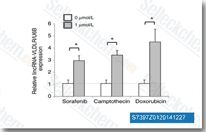
|
| S2475 |
Imatinib
|
Imatinib is a multi-target inhibitor of tyrosine kinase with inhibition for v-Abl, c-Kit and PDGFR, IC50 values are 0.6 μM, 0.1 μM and 0.1 μM in cell-free or cell-based assays, respectively. Imatinib (STI571) induces autophagy.
|
-
Cancer Cell, 2025, 43(4):776-796.e14
-
Theranostics, 2025, 15(8):3589-3609
-
Genome Med, 2025, 17(1):14
|
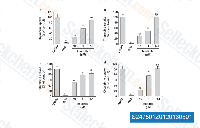
|
| S1040 |
Sorafenib tosylate
|
Sorafenib tosylate is a multikinase inhibitor of Raf-1 and B-Raf with IC50 of 6 nM and 22 nM in cell-free assays, respectively. This compound inhibits VEGFR-2, VEGFR-3, PDGFR-β, Flt-3 and c-KIT with IC50 of 90 nM, 20 nM, 57 nM, 59 nM and 68 nM, respectively. It induces autophagy and apoptosis and activates ferroptosis with anti-tumor activity.
|
-
Int J Oncol, 2025, 67(3)72
-
Nature, 2024, 629(8013):927-936
-
Cell Mol Life Sci, 2024, 81(1):238
|
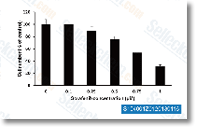
|
| S1026 |
Imatinib (STI571) Mesylate
|
Imatinib Mesylate is an orally bioavailability mesylate salt of Imatinib, which is a multi-target inhibitor of v-Abl, c-Kit and PDGFR with IC50 of 0.6 μM, 0.1 μM and 0.1 μM in cell-free or cell-based assays, respectively. Imatinib Mesylate (STI571) induces autophagy.
|
-
Sci Immunol, 2025, 10(109):eads5818
-
Blood Adv, 2025, bloodadvances.2024015364
-
Eur J Med Chem, 2025, 284:117211
|
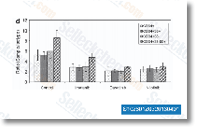
|
| S7781 |
Sunitinib (SU-11248)
|
Sunitinib is a multi-targeted RTK inhibitor targeting VEGFR2 (Flk-1) and PDGFRβ with IC50 of 80 nM and 2 nM, and also inhibits c-Kit. Sunitinib is also a dose-dependent inhibitor of the autophosphorylation activity of IRE1α. Sunitinib induces autophagy and apoptosis.
|
-
Cancer Cell, 2025, 43(4):776-796.e14
-
Mol Cancer, 2025, 24(1):179
-
J Exp Clin Cancer Res, 2025, 44(1):290
|
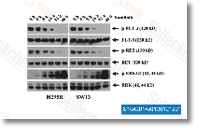
|
| S1490 |
Ponatinib (AP24534)
|
Ponatinib is a novel, potent multi-target inhibitor of Abl, PDGFRα, VEGFR2, FGFR1 and Src with IC50 of 0.37 nM, 1.1 nM, 1.5 nM, 2.2 nM and 5.4 nM in cell-free assays, respectively. Ponatinib (AP24534) inhibits autophagy.
|
-
Nat Commun, 2025, 16(1):471
-
Theranostics, 2025, 15(8):3589-3609
-
J Exp Clin Cancer Res, 2025, 44(1):290
|
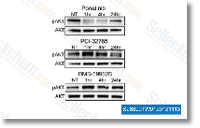
|
| S1178 |
Regorafenib (BAY 73-4506)
|
Regorafenib is a multi-target inhibitor for VEGFR1, VEGFR2, VEGFR3, PDGFRβ, Kit (c-Kit), RET (c-RET) and Raf-1 with IC50 of 13 nM/4.2 nM/46 nM, 22 nM, 7 nM, 1.5 nM and 2.5 nM in cell-free assays, respectively. Regorafenib induces autophagy.
|
-
Nat Commun, 2025, 16(1):509
-
Cell Death Differ, 2025, 10.1038/s41418-025-01536-1
-
Cell Mol Gastroenterol Hepatol, 2025, S2352-345X(25)00026-8
|
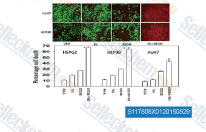
|
| S1005 |
Axitinib (AG-013736)
|
Axitinib is a multi-target inhibitor of VEGFR1, VEGFR2, VEGFR3, PDGFRβ and c-Kit with IC50 of 0.1 nM, 0.2 nM, 0.1-0.3 nM, 1.6 nM and 1.7 nM in Porcine aorta endothelial cells, respectively.
|
-
Cancer Cell, 2025, S1535-6108(25)00070-4
-
Chem Biol Interact, 2025, 418:111628
-
Development, 2025, 152(13)dev204684
|
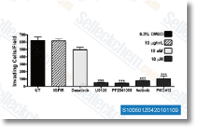
|
| S1042 |
Sunitinib malate
|
Sunitinib malate is a multi-targeted RTK inhibitor targeting VEGFR2 (Flk-1) and PDGFRβ with IC50 of 80 nM and 2 nM in cell-free assays, and also inhibits c-Kit. Sunitinib Malate effectively inhibits autophosphorylation of Ire1α. Sunitinib Malate increases both death receptor and mitochondrial-dependent apoptosis.
|
-
CNS Neurosci Ther, 2025, 31(12):e70696
-
Sci Rep, 2025, 15(1):35889
-
Cell Oncol (Dordr), 2024, 10.1007/s13402-024-00939-5
|
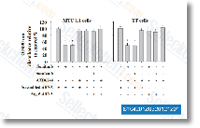
|
| S1010 |
Nintedanib (BIBF 1120)
|
Nintedanib is a potent triple angiokinase inhibitor for VEGFR1/2/3, FGFR1/2/3 and PDGFRα/β with IC50 of 34 nM/13 nM/13 nM, 69 nM/37 nM/108 nM and 59 nM/65 nM in cell-free assays. Phase 3.
|
-
Nat Commun, 2025, 16(1):471
-
Cell Death Dis, 2025, 16(1):196
-
Eur J Pharmacol, 2025, 1005:178058
|
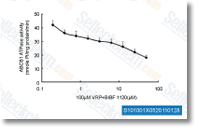
|
| S1164 |
Lenvatinib (E7080)
|
Lenvatinib is a multi-target inhibitor, mostly for VEGFR2(KDR)/VEGFR3(Flt-4) with IC50 of 4 nM/5.2 nM, less potent against VEGFR1/Flt-1, ~10-fold more selective for VEGFR2/3 against FGFR1, PDGFRα/β in cell-free assays. This compound also inhibits FGFR1-4, PDGFR, Kit (c-Kit), RET (c-RET), and shows potent antitumor activities. Phase 3.
|
-
Nature, 2025, 10.1038/s41586-025-08585-z
-
Drug Resist Updat, 2025, 81:101224
-
Nat Commun, 2025, 16(1):6451
|
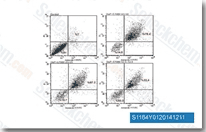
|
| S2730 |
Crenolanib
|
Crenolanib is a potent and selective inhibitor of PDGFRα/β with Kd of 2.1 nM/3.2 nM in CHO cells, also potently inhibits FLT3, sensitive to D842V mutation not V561D mutation, >100-fold more selective for PDGFR than c-Kit, VEGFR-2, TIE-2, FGFR-2, EGFR, erbB2, and Src. This compound helps to induce mitophagy.
|
-
Cancer Cell, 2025, S1535-6108(25)00070-4
-
Nat Commun, 2025, 16(1):1358
-
J Extracell Vesicles, 2025, 14(9):e70163
|
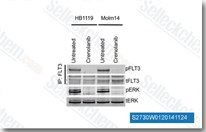
|
| S1111 |
Foretinib
|
Foretinib is an ATP-competitive inhibitor of HGFR and VEGFR, mostly for Met (c-Met) and KDR with IC50 of 0.4 nM and 0.9 nM in cell-free assays. Less potent against Ron, Flt-1/3/4, Kit (c-Kit), PDGFRα/β and Tie-2, and little activity to FGFR1 and EGFR. Phase 2.
|
-
J Microbiol, 2025, 63(2):e2409001
-
Int J Mol Sci, 2023, 24(1)757
-
Biol Open, 2023, 12(8)bio059994
|
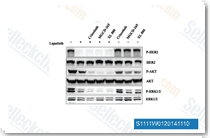
|
| S3012 |
Pazopanib
|
Pazopanib (GW786034) is a novel multi-target inhibitor of VEGFR1, VEGFR2, VEGFR3, PDGFR, FGFR, c-Kit and c-Fms/CSF1R with IC50 of 10 nM, 30 nM, 47 nM, 84 nM, 74 nM, 140 nM and 146 nM in cell-free assays, respectively. This compound induces cathepsin B activation and autophagy.
|
-
Nucleic Acids Res, 2025, 53(4)gkaf107
-
Commun Biol, 2025, 8(1):1185
-
Sci Rep, 2025, 15(1):35889
|

|
| S1017 |
Cediranib (AZD2171)
|
Cediranib (AZD2171, NSC-732208) is a highly potent VEGFR(KDR) inhibitor with IC50 of <1 nM, also inhibits Flt1/4 with IC50 of 5 nM/≤3 nM, and shows similar activity against c-Kit and PDGFRβ. It is 36-, 110-fold and >1000-fold more selective for VEGFR than PDGFR-α, CSF-1R and Flt3 in HUVEC cells. This compound induces autophagic vacuole accumulation and is in Phase 3.
|
-
Front Oncol, 2024, 14:1302850
-
Cell Oncol (Dordr), 2023, 46(2):391-407
-
Cell Oncol (Dordr), 2023, 46(2):391-407
|
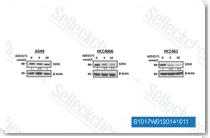
|
| S1035 |
Pazopanib HCl
|
Pazopanib HCl is a novel multi-target inhibitor of VEGFR1, VEGFR2, VEGFR3, PDGFR, FGFR, c-Kit and c-Fms with IC50 of 10 nM, 30 nM, 47 nM, 84 nM, 74 nM, 140 nM and 146 nM in cell-free assays, respectively. Pazopanib induces autophagic Type II cell death.
|
-
iScience, 2024, 27(10):110862
-
iScience, 2023, 26(7):107116
-
NPJ Breast Cancer, 2022, 8(1):44
|
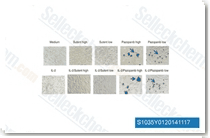
|
| S1018 |
Dovitinib (TKI-258)
|
Dovitinib (TKI-258, CHIR258) is a multitargeted RTK inhibitor, primarily targeting class III RTKs (FLT3/c-Kit) with IC50 values of 1 nM/2 nM. It is also potent against class IV (FGFR1/3) and class V (VEGFR1-4) RTKs, exhibiting IC50 values of 8–13 nM, while showing lower potency toward InsR, EGFR, c-Met, EphA2, Tie2, IGF-1R, and HER2 in cell-free assays. Phase 4.
|
-
Spectrochim Acta A Mol Biomol Spectrosc, 2025, 343:126602
-
Biomed Pharmacother, 2024, 180:117533
-
Sci Rep, 2023, 13(1):20223
|
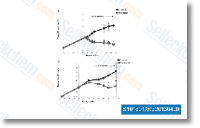
|
| S8064 |
Midostaurin (PKC412)
|
Midostaurin is a multi-targeted kinase inhibitor, including PKCα/β/γ, Syk, Flk-1, Akt, PKA, c-Kit, c-Fgr, c-Src, FLT3, PDFRβ and VEGFR1/2 with IC50 ranging from 80-500 nM.
|
-
Blood Adv, 2025, bloodadvances.2024015427
-
Onco Targets Ther, 2025, 18:489-501
-
Blood Cancer J, 2024, 14(1):207
|
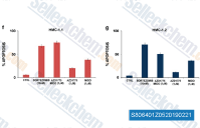
|
| S5077 |
Regorafenib (BAY-734506) Monohydrate
|
Regorafenib (BAY-734506, Fluoro-sorafenib, Resihance, Stivarga, regorafaenib monohydrate) Monohydrate is a novel oral multikinase inhibitor with IC50 values of 13, 4.2, 46, 22, 7, 1.5, 2.5, 28, 19 nM for VEGFR1, murine VEGFR2, murine VEGFR3, PDGFR-β, Kit (c-Kit), RET (c-RET), RAF-1, B-RAF and B-RAF(V600E) respectively.
|
-
Nature, 2024, 629(8011):450-457
-
iScience, 2024, 27(10):110862
-
STAR Protoc, 2024, 5(2):103090
|
|
| S1064 |
Masitinib
|
Masitinib is a novel inhibitor for Kit (c-Kit) and PDGFRα/β with IC50 of 200 nM and 540 nM/800 nM, weak inhibition to ABL and c-Fms. Phase 3.
|
-
Cancer Res, 2025, 10.1158/0008-5472.CAN-24-2220
-
iScience, 2024, 27(10):110862
-
bioRxiv, 2024, 2023.11.21.568071
|
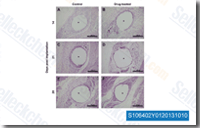
|
| S1207 |
Tivozanib
|
Tivozanib is a potent and selective VEGFR inhibitor for VEGFR1/2/3 with IC50 of 30 nM/6.5 nM/15 nM, and also inhibits PDGFR and c-Kit, low activity observed against FGFR-1, Flt3, c-Met, EGFR and IGF-1R. Phase 3.
|
-
bioRxiv, 2025, 2025.01.24.634732
-
Nat Commun, 2024, 15(1):4758
-
Nat Commun, 2024, 15(1):4758
|
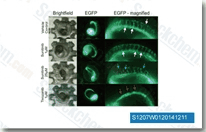
|
| S8401 |
Erdafitinib (JNJ-42756493)
|
Erdafitinib is a potent and selective orally bioavailable, pan fibroblast growth factor receptor (FGFR) inhibitor with potential antineoplastic activity. This compound also binds to RET (c-RET), CSF-1R, PDGFR-α/PDGFR-β, FLT4, Kit (c-Kit) and VEGFR-2 and induces cellular apoptosis.
|
-
Commun Biol, 2025, 8(1):394
-
Int J Mol Sci, 2025, 26(8)3525
-
J Clin Invest, 2024, 134(2)e169241
|
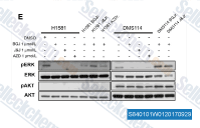
|
| S1003 |
Linifanib (ABT-869)
|
Linifanib (ABT-869, AL39324, RG3635) is a novel, potent ATP-competitive VEGFR/PDGFR inhibitor for KDR, CSF-1R, Flt-1/3 and PDGFRβ with IC50 of 4 nM, 3 nM, 3 nM/4 nM and 66 nM respectively, mostly effective in mutant kinase-dependent cancer cells (i.e. FLT3). This compound induces autophagy and apoptosis, and is in Phase 3.
|
-
Biomed Pharmacother, 2024, 180:117533
-
Cell Death Discov, 2023, 9(1):57
-
Cell Death Discov, 2023, 9(1):57
|
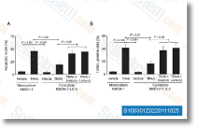
|
| S7765 |
Dovitinib (TKI258) Lactate monohydrate
|
Dovitinib (TKI258) Lactate monohydrate is the Lactate of Dovitinib, which is a multitargeted RTK inhibitor, mostly for class III (FLT3/c-Kit) with IC50 of 1 nM/2 nM, also potent to class IV (FGFR1/3) and class V (VEGFR1-4) RTKs with IC50 of 8-13 nM, less potent to InsR, EGFR, c-Met, EphA2, Tie2, IGFR1 and HER2. Phase 4.
|
-
Mol Cell, 2021, S1097-2765(21)00507-4
-
Acta Neuropathol, 2021, 10.1007/s00401-021-02327-x
-
Cancer Res, 2021, canres.1780.2020
|
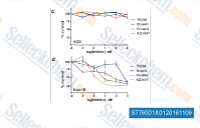
|
| S5240 |
Lenvatinib Mesylate
|
Lenvatinib Mesylate is a synthetic, orally available tyrosine kinase inhibitor that inhibits vascular endothelial growth factor receptor (VEGFR1-3), fibroblast growth factor receptor (FGFR1-4), platelet-derived growth factor receptor α (PDGFRα), stem cell factor receptor (Kit (c-Kit)), and rearranged during transfection (RET (c-RET)). This compound has potential antineoplastic activity.
|
-
Nat Commun, 2024, 15(1):1754
-
iScience, 2024, 27(10):110862
-
J Hepatocell Carcinoma, 2023, 10:697-712
|
|
| S1536 |
CP-673451
|
CP-673451 is a selective inhibitor of PDGFRα/β with IC50 of 10 nM/1 nM in cell-free assays, exhibits >450-fold selectivity over other angiogenic receptors, has antiangiogenic and antitumor activity.
|
-
Nat Biotechnol, 2025, 10.1038/s41587-025-02833-3
-
Cancer Res, 2025, 10.1158/0008-5472.CAN-24-2220
-
Cell Rep Med, 2024, S2666-3791(24)00201-5
|
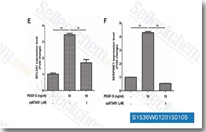
|
| S1470 |
Orantinib (SU6668)
|
Orantinib (SU6668) has greatest potency against PDGFR autophosphorylation with Ki of 8 nM in a cell-free assay, but also strongly inhibits Flk-1 and FGFR1 trans-phosphorylation. It shows little activity against IGF-1R, Met, Src, Lck, Zap70, Abl and CDK2, and does not inhibit EGFR. This compound is in Phase 3.
|
-
bioRxiv, 2023, 2023.05.11.540170
-
bioRxiv, 2023, 2023.05.11.540170
-
J Pers Med, 2022, 12(2)258
|
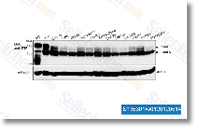
|
| S4947 |
Regorafenib Hydrochloride
|
Regorafenib (Stivarga, BAY 73-4506) Hydrochloride is a multi-target inhibitor for VEGFR1, Murine VEGFR2/3, PDGFRβ, Kit (c-Kit), RET (c-RET) and Raf-1 with IC50 of 13 nM, 4.2 nM/46 nM, 22 nM, 7 nM, 1.5 nM and 2.5 nM, respectively.
|
-
Cancers (Basel), 2023, 15(18)4477
-
Cancers (Basel), 2023, 15(18)4477
-
J Clin Med, 2023, 12(23)7267
|
|
| S1363 |
Ki8751
|
Ki8751 is a potent and selective inhibitor of VEGFR2 with IC50 of 0.9 nM, >40-fold selective for VEGFR2 than c-Kit, PDGFRα and FGFR-2, little activity to EGFR, HGFR and InsR.
|
-
Elife, 2025, 13RP98612
-
Nat Commun, 2024, 15(1):2539
-
Drug Des Devel Ther, 2023, 17:1567-1582
|
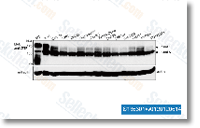
|
| S1244 |
Amuvatinib (MP-470)
|
Amuvatinib (MP-470, HPK 56) is a potent and multi-targeted inhibitor of c-Kit, PDGFRα and Flt3 with IC50 of 10 nM, 40 nM and 81 nM, respectively. It suppresses c-MET and c-RET, and is also active as a DNA repair protein Rad51 inhibitor with antineoplastic activity. Phase 2.
|
-
Cancer Res, 2025, 10.1158/0008-5472.CAN-24-2220
-
Hematol Oncol, 2025, 43(5):e70131
-
bioRxiv, 2024, 2023.11.21.568071
|
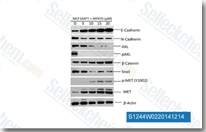
|
| S5234 |
Nintedanib Ethanesulfonate Salt
|
Nintedanib (Intedanib, BIBF 1120) is a small molecule tyrosine-kinase inhibitor with IC50 of 34 nM/13 nM/13 nM, 69 nM/37 nM/108 nM and 59 nM/65 nM for VEGFR1/2/3, FGFR1/2/3 and PDGFRα/β, respectively.
|
-
iScience, 2024, 27(10):110862
-
Am J Cancer Res, 2023, 13(2):355-378
-
Theranostics, 2022, 12(2):747-766
|
|
| S7667 |
SU5402
|
SU5402 is a potent multi-targeted receptor tyrosine kinase inhibitor with IC50 of 20 nM, 30 nM, and 510 nM for VEGFR2, FGFR1, and PDGF-Rβ, respectively.
|
-
Int J Mol Sci, 2025, 26(8)3536
-
Basic Clin Pharmacol Toxicol, 2025, 136(5):e70022
-
Sci Adv, 2025, 11(30):eadi2370
|
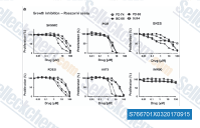
|
| S8024 |
Tyrphostin AG 1296
|
Tyrphostin AG 1296 is an inhibitor of PDGFR with IC50 of 0.3-0.5 μM, no activity to EGFR. Tyrphostin AG1296 inhibits FGFR and c-Kit with IC50 of 12.3 μM and 1.8 μM in Swiss 3T3 cells. Tyrphostin AG1296 induces dramatic apoptosis in A375R cells.
|
-
Dev Cell, 2022, 57(12):1466-1481.e6
-
Front Pharmacol, 2021, 12:804327
-
Mol Med Rep, 2021, 23(4):1
|
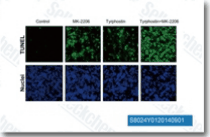
|
| S1032 |
Motesanib Diphosphate (AMG-706)
|
Motesanib Diphosphate (AMG-706) is a potent ATP-competitive inhibitor of VEGFR1/2/3 with IC50 of 2 nM/3 nM/6 nM, respectively. It shows similar activity against Kit (c-Kit) and is ~10-fold more selective for VEGFR than PDGFR and Ret. This compound is in Phase 3.
|
-
Front Cell Dev Biol, 2022, 10:836179
-
J Pharm Sci, 2022, 111(8):2180-2190
-
Drug Metab Dispos, 2021, 49(1):53-61
|
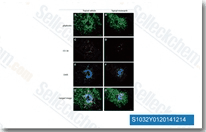
|
| S8553 |
Avapritinib (BLU-285)
|
Avapritinib (BLU-285) is a small molecule kinase inhibitor that potently inhibits PDGFRα D842V mutant activity in vitro (IC50 = 0.5 nM) and PDGFRα D842V autophosphorylation in the cellular setting (IC50 = 30 nM). It is also a potent inhibitor of the analogous Kit (c-Kit) mutation, D816V in Kit (c-Kit) Exon 17 (IC50 = 0.5 nM).
|
-
Cancer Cell, 2025, S1535-6108(25)00070-4
-
Sci Rep, 2024, 14(1):7204
-
Curr Drug Metab, 2024, 25(3):197-204
|
|
| S1181 |
ENMD-2076
|
ENMD-2076 has selective activity against Aurora A and Flt3 with IC50 of 14 nM and 1.86 nM, 25-fold selective for Aurora A than over Aurora B and less potent to RET, SRC, NTRK1/TRKA, CSF1R/FMS, VEGFR2/KDR, FGFR and PDGFRα. This compound inhibits the growth of a wide range of human solid tumor and hematopoietic cancer cell lines with IC50 from 0.025 to 0.7 μM, which induces apoptosis and G2/M phase arrest. Phase 2.
|
-
Int J Biol Macromol, 2025, 292:139119
-
Cell, 2021, 184(2):334-351.e20
-
Sci Adv, 2021, 7(4)eabd7851
|
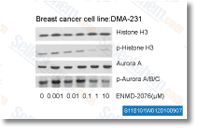
|
| S4736 |
Trapidil
|
Trapidil (Rocornal, Trapymin, Avantrin, Trapymine) is a PDGF antagonist that can inhibit the proliferation of the PDGF-producing glioma cells.
|
-
J Immunother Cancer, 2024, 12(11)e009805
-
J Pers Med, 2022, 12(2)258
-
Hum Cell, 2022, 10.1007/s13577-022-00671-y
|
|
| S8757 |
Ripretinib
|
Ripretinib is an orally bioavailable switch pocket control inhibitor of wild-type and mutated forms of the tumor-associated antigens (TAA) mast/stem cell factor receptor (SCFR) Kit (c-Kit) and PDGFR-alpha, with IC50 values of 4 nM, 8 nM, 18 nM, 5 nM and 14 nM for WT Kit (c-Kit), V654A Kit (c-Kit), T670I Kit (c-Kit), D816H Kit (c-Kit) and D816V Kit (c-Kit), respectively.
|
-
Nature, 2024, 629(8011):450-457
-
Nature, 2024, 629(8011):450-457
-
Cell Rep Med, 2024, S2666-3791(24)00201-5
|
|
| S2622 |
PP121
|
PP-121 is a multi-targeted inhibitor of PDGFR, Hck, mTOR, VEGFR2, Src and Abl with IC50 of 2 nM, 8 nM, 10 nM, 12 nM, 14 nM and 18 nM, also inhibits DNA-PK with IC50 of 60 nM.
|
-
Life Sci Alliance, 2021, 4(2)e202000882
-
PLoS One, 2016, 11(10):e0164895
-
PLoS One, 2016, 11(10):e0164895
|
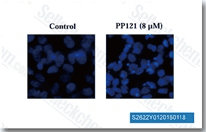
|
| S8015 |
Agerafenib (CEP-32496)
|
Agerafenib (CEP-32496) is a highly potent inhibitor of BRAF(V600E/WT) and c-Raf with Kd of 14 nM/36 nM and 39 nM, respectively. It also shows potent activity against Abl-1, c-Kit, Ret (c-Ret), PDGFRβ and VEGFR2, but has insignificant affinity for MEK-1, MEK-2, ERK-1 and ERK-2. This compound is currently in Phase 1/2 clinical trials.
|
-
Mol Pharmacol, 2021, 99(6):435-447
-
Dis Model Mech, 2020, dmm.047779
-
Cancer Immunol Res, 2019,
|
|
| S2231 |
Telatinib
|
Telatinib (BAY 57-9352) is a potent inhibitor of VEGFR2/3, c-Kit and PDGFRα with IC50 of 6 nM/4 nM, 1 nM and 15 nM, respectively. Phase 2.
|
-
Sci Adv, 2022, 8(6):eabg9455
-
Leiden University Scholarly Publications, 2020, N/A
-
Cell Stem Cell, 2019, 24(4):654-669
|
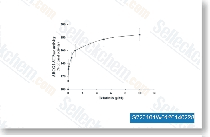
|
| S2774 |
MK-2461
|
MK-2461 is a potent, multi-targeted inhibitor for c-Met(WT/mutants) with IC50 of 0.4-2.5 nM, less potent to Ron, Flt1; 8- to 30-fold greater selectivity of c-Met targets versus FGFR1, FGFR2, FGFR3, PDGFRβ, KDR, Flt3, Flt4, TrkA, and TrkB. Phase 1/2.
|
-
Mol Carcinog, 2021, 60(7):481-496
-
G3 (Bethesda), 2021, 11(10)jkab265
-
Mol Cell Biochem, 2018, 449(1-2):1-8
|
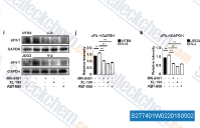
|
| S7003 |
AZD2932
|
AZD2932 is a potent and mutil-targeted protein tyrosine kinase inhibitor with IC50 of 8 nM, 4 nM, 7 nM, and 9 nM for VEGFR-2, PDGFRβ, Flt-3, and c-Kit, respectively.
|
-
Cancer Res, 2020, canres.1992.2020
-
Molecules, 2020, 8;25(9) pii: E2220
-
Development, 2016, 143(23):4394-4404
|
|
| S0504 |
SU14813
|
SU14813 (SU 014813) is a multiple receptor tyrosine kinase inhibitor with IC50 of 50 nM, 2 nM, 4 nM and 15 nM for VEGFR2, VEGFR1, PDGFRβ and Kit (c-Kit). This compound exhibits potent antiangiogenic and antitumor activity.
|
-
Cancer Cell, 2022, S1535-6108(22)00312-9
-
Adv Sci (Weinh), 2021, e2101848
|
|
| S8721 |
PDGFR inhibitor 1
|
PDGFR inhibitor 1 is an orally bioavailable switch pocket control inhibitor of wild-type and mutated forms of Kit (c-Kit) and PDGFR with potential antineoplastic activity. It also inhibits several other kinases, including VEGFR2, TIE2, PDGFR-beta and CSF1R, thereby further inhibiting tumor cell growth.
|
-
bioRxiv, 2025, 2025.06.11.659120
-
Elife, 2023, 12e79840
-
Elife, 2023, 12e79840
|
|
| S6526 |
SKLB 610
|
SKLB-610 is a multi-target inhibitor of the tyrosine kinases. It is most potent against VEGFR2 and exhibits slightly weaker inhibitor of FGFR2 and PDGFR.
|
-
Biomed Pharmacother, 2022, 149:112922
-
Int J Mol Sci, 2022, 23(14)7853
|
|
| S8161 |
ON123300
|
ON123300 is a potent and multi-targeted kinase inhibitor with IC50 of 3.9 nM, 5 nM, 26 nM, 26 nM, 9.2 nM and 11nM for CDK4, Ark5/NUAK1, PDGFRβ, FGFR1, RET (c-RET), and Fyn, respectively.
|
-
Cell Rep Med, 2025, S2666-3791(25)00231-9
-
Cell Rep, 2024, 43(7):114446
-
J Cell Sci, 2021, jcs.258685
|
|
| S2895 |
Tyrphostin 9
|
Tyrphostin 9 (SF 6847, RG-50872) is firstly designed as an EGFR inhibitor with IC50 of 460 μM, but is also found to be more potent to PDGFR with IC50 of 0.5 μM.
|
-
Cell Rep, 2022, 38(10):110475
|
|
| E4449 |
AG 825
|
AG-825 (Tyrphostin AG-825) is a potent and selective inhibitor of ErbB2 with IC50 values of 0.15 µM. It also inhibits PDGFR autophosphorylation with IC50 value of 40 µM. It exhibits anti-cancer activity and significantly induces apoptosis in cancer cells.
|
|
|
| S7688 |
Ki20227
|
Ki20227 is an orally active and highly selective inhibitor of c-Fms tyrosine kinase(CSF1R) with IC50 of 2 nM, 12 nM, 451 nM and 217 nM for c-Fms, vascular endothelial growth factor receptor-2 (KDR/VEGFR-2), stem cell factor receptor (c-Kit), and platelet-derived growth factor receptor beta (PDGFRβ), respectively.
|
-
Cancer Immunol Immunother, 2024, 73(5):76
-
Cancer Immunol Immunother, 2024, 73(5):76
|
|
| S5272 |
Toceranib phosphate
|
Toceranib phosphate (Palladia, SU11654), the phosphate salt of toceranib, is a selective inhibitor of the tyrosine kinase activity of several members of the split kinase RTK family, including Flk-1/KDR, PDGFR, and Kit with Ki values of 6 nM and 5 nM for Flk-1/KDR and PDGFRβ, respectively.
|
-
Front Vet Sci, 2024, 11:1392728
|
|
| S4018 |
Sennoside B
|
Sennoside B, a kind of irritant laxative isolated from rhei rhizome, inhibits PDGF-stimulated cell proliferation.
|
|
|
| S0763 |
Tyrphostin AG1433
|
Tyrphostin AG1433 (AG1433, SU1433) is a selective platelet-derived growth factor receptor β (PDGFRβ) and vascular endothelial growth factor receptor 2 (VEGFR-2, Flk-1/KDR) inhibitor with IC50s of 5.0 μM and 9.3 μM, respectively.
|
|
|
| E0616 |
Chiauranib
|
Chiauranib (CS2164) selectively inhibits multiple kinase targets aurora B kinase (AURKB), colony-stimulating factor 1 receptor (CSF1R), and vascular endothelial growth factor receptor (VEGFR)/platelet-derived growth factor receptor (PDGFR)/c-Kit , thereby inhibiting the rapid proliferation of tumor cells, enhancing the antitumor immunity, and inhibiting tumor angiogenesis, to achieve the anti-tumor efficacy.
|
|
|
| E2828 |
AG 1295
|
AG 1295 is a selective and specific inhibitor of platelet-derived growth factor receptor (PDGFR) tyrosine-kinase. It inhibits PDGFR autophosphorylation with IC50 values of 0.3-0.5 μM in membrane autophosphorylation assays, respectively.
|
|
|
| S6843 |
Vorolanib
|
Vorolanib (X-82,CM082) is an oral, multikinase, dual inhibitor of vascular endothelial growth factor receptor (VEGFR) and platelet-derived growth factor receptor (PDGFR) with antiangiogenic and antineoplastic activities.
|
|
|
| E0814 |
Masitinib mesylate
|
Masitinib mesylate (AB-1010 mesylate) is a potent, orally bioavailable, and selective inhibitor of c-Kit with IC50 of 200 nM for human recombinant c-Kit, also inhibits PDGFRα/β with IC50s of 540/800 nM, Lyn with IC50 of 510 nM for LynB, and, to a lesser extent, FGFR3 and FAK.
|
|
|
| S8780 |
AZD3229
|
AZD3229 is a potent, pan-Kit (c-Kit) mutant inhibitor with potent single digit nM growth inhibition against a diverse panel of mutant Kit (c-Kit) driven Ba/F3 cell lines (GI50=1-50 nM), with good margin to KDR-driven effects. It also inhibits PDGFR mutants (Tel-PDGFRα, Tel-PDGFRβ, V561D/D842V).
|
|
|
| E2548 |
N-(p-Coumaroyl) Serotonin
|
N-(p-Coumaroyl) Serotonin (p-coumaroylserotonin) is a polyphenol isolated from the seeds of safflower and has antioxidative, anti-atherogenic and anti-inflammatory properties, can inhibits PDGF-induced on phosphorylation of PDGF receptor and Ca2+ release from sarcoplasmic reticulum.
|
|
|
| E0050 |
Seralutinib (GB002)
|
Seralutinib (PK10571, GB002) is a novel PDGFR kinase inhibitor with IC50s of 8 nM and 10 nM for PDGFRα and PDGFRβ in enzyme assays, respectively.
|
|
|
| E2393 |
JNJ-10198409
|
JNJ-10198409, a relatively selective, orally active, and ATP competitive PDGF-RTK (platelet-derived growth factor receptor tyrosine kinase) inhibitor with IC50 of 2 nM, is a dual-mechanism, antiangiogenic, and tumor cell antiproliferative agent, has good activity against PDGFRβ kinase and PDGFRα kinase with IC50 of 4.2 and 45 nM, respectively.
|
|
|
| S9973 |
Flumatinib (HH-GV-678)
|
Flumatinib (HH-GV-678) is a novel inhibitor of Bcr-Abl with IC50 values of 1.2 nM, 307.6 nM and 665.5 nM for c-Abl, PDGFRβand c-Kit, respectively.
|
|
|
| S7397 |
Sorafenib (BAY 43-9006)
|
Sorafenib is a multikinase inhibitor of Raf-1 and B-Raf with IC50 of 6 nM and 22 nM in cell-free assays, respectively. Sorafenib inhibits VEGFR-2, VEGFR-3, PDGFR-β, Flt-3 and c-KIT with IC50 of 90 nM, 20 nM, 57 nM, 59 nM and 68 nM, respectively. Sorafenib induces autophagy and apoptosis and activates ferroptosis with anti-tumor activity. |
- Mol Cancer, 2025, 24(1):34
- Nat Commun, 2025, 16(1):509
- Adv Sci (Weinh), 2025, 12(30):e04372
|

|
| S2475 |
Imatinib
|
Imatinib is a multi-target inhibitor of tyrosine kinase with inhibition for v-Abl, c-Kit and PDGFR, IC50 values are 0.6 μM, 0.1 μM and 0.1 μM in cell-free or cell-based assays, respectively. Imatinib (STI571) induces autophagy. |
- Cancer Cell, 2025, 43(4):776-796.e14
- Theranostics, 2025, 15(8):3589-3609
- Genome Med, 2025, 17(1):14
|

|
| S1040 |
Sorafenib tosylate
|
Sorafenib tosylate is a multikinase inhibitor of Raf-1 and B-Raf with IC50 of 6 nM and 22 nM in cell-free assays, respectively. This compound inhibits VEGFR-2, VEGFR-3, PDGFR-β, Flt-3 and c-KIT with IC50 of 90 nM, 20 nM, 57 nM, 59 nM and 68 nM, respectively. It induces autophagy and apoptosis and activates ferroptosis with anti-tumor activity. |
- Int J Oncol, 2025, 67(3)72
- Nature, 2024, 629(8013):927-936
- Cell Mol Life Sci, 2024, 81(1):238
|

|
| S1026 |
Imatinib (STI571) Mesylate
|
Imatinib Mesylate is an orally bioavailability mesylate salt of Imatinib, which is a multi-target inhibitor of v-Abl, c-Kit and PDGFR with IC50 of 0.6 μM, 0.1 μM and 0.1 μM in cell-free or cell-based assays, respectively. Imatinib Mesylate (STI571) induces autophagy. |
- Sci Immunol, 2025, 10(109):eads5818
- Blood Adv, 2025, bloodadvances.2024015364
- Eur J Med Chem, 2025, 284:117211
|

|
| S7781 |
Sunitinib (SU-11248)
|
Sunitinib is a multi-targeted RTK inhibitor targeting VEGFR2 (Flk-1) and PDGFRβ with IC50 of 80 nM and 2 nM, and also inhibits c-Kit. Sunitinib is also a dose-dependent inhibitor of the autophosphorylation activity of IRE1α. Sunitinib induces autophagy and apoptosis. |
- Cancer Cell, 2025, 43(4):776-796.e14
- Mol Cancer, 2025, 24(1):179
- J Exp Clin Cancer Res, 2025, 44(1):290
|

|
| S1490 |
Ponatinib (AP24534)
|
Ponatinib is a novel, potent multi-target inhibitor of Abl, PDGFRα, VEGFR2, FGFR1 and Src with IC50 of 0.37 nM, 1.1 nM, 1.5 nM, 2.2 nM and 5.4 nM in cell-free assays, respectively. Ponatinib (AP24534) inhibits autophagy. |
- Nat Commun, 2025, 16(1):471
- Theranostics, 2025, 15(8):3589-3609
- J Exp Clin Cancer Res, 2025, 44(1):290
|

|
| S1178 |
Regorafenib (BAY 73-4506)
|
Regorafenib is a multi-target inhibitor for VEGFR1, VEGFR2, VEGFR3, PDGFRβ, Kit (c-Kit), RET (c-RET) and Raf-1 with IC50 of 13 nM/4.2 nM/46 nM, 22 nM, 7 nM, 1.5 nM and 2.5 nM in cell-free assays, respectively. Regorafenib induces autophagy. |
- Nat Commun, 2025, 16(1):509
- Cell Death Differ, 2025, 10.1038/s41418-025-01536-1
- Cell Mol Gastroenterol Hepatol, 2025, S2352-345X(25)00026-8
|

|
| S1005 |
Axitinib (AG-013736)
|
Axitinib is a multi-target inhibitor of VEGFR1, VEGFR2, VEGFR3, PDGFRβ and c-Kit with IC50 of 0.1 nM, 0.2 nM, 0.1-0.3 nM, 1.6 nM and 1.7 nM in Porcine aorta endothelial cells, respectively. |
- Cancer Cell, 2025, S1535-6108(25)00070-4
- Chem Biol Interact, 2025, 418:111628
- Development, 2025, 152(13)dev204684
|

|
| S1042 |
Sunitinib malate
|
Sunitinib malate is a multi-targeted RTK inhibitor targeting VEGFR2 (Flk-1) and PDGFRβ with IC50 of 80 nM and 2 nM in cell-free assays, and also inhibits c-Kit. Sunitinib Malate effectively inhibits autophosphorylation of Ire1α. Sunitinib Malate increases both death receptor and mitochondrial-dependent apoptosis. |
- CNS Neurosci Ther, 2025, 31(12):e70696
- Sci Rep, 2025, 15(1):35889
- Cell Oncol (Dordr), 2024, 10.1007/s13402-024-00939-5
|

|
| S1010 |
Nintedanib (BIBF 1120)
|
Nintedanib is a potent triple angiokinase inhibitor for VEGFR1/2/3, FGFR1/2/3 and PDGFRα/β with IC50 of 34 nM/13 nM/13 nM, 69 nM/37 nM/108 nM and 59 nM/65 nM in cell-free assays. Phase 3. |
- Nat Commun, 2025, 16(1):471
- Cell Death Dis, 2025, 16(1):196
- Eur J Pharmacol, 2025, 1005:178058
|

|
| S1164 |
Lenvatinib (E7080)
|
Lenvatinib is a multi-target inhibitor, mostly for VEGFR2(KDR)/VEGFR3(Flt-4) with IC50 of 4 nM/5.2 nM, less potent against VEGFR1/Flt-1, ~10-fold more selective for VEGFR2/3 against FGFR1, PDGFRα/β in cell-free assays. This compound also inhibits FGFR1-4, PDGFR, Kit (c-Kit), RET (c-RET), and shows potent antitumor activities. Phase 3. |
- Nature, 2025, 10.1038/s41586-025-08585-z
- Drug Resist Updat, 2025, 81:101224
- Nat Commun, 2025, 16(1):6451
|

|
| S2730 |
Crenolanib
|
Crenolanib is a potent and selective inhibitor of PDGFRα/β with Kd of 2.1 nM/3.2 nM in CHO cells, also potently inhibits FLT3, sensitive to D842V mutation not V561D mutation, >100-fold more selective for PDGFR than c-Kit, VEGFR-2, TIE-2, FGFR-2, EGFR, erbB2, and Src. This compound helps to induce mitophagy. |
- Cancer Cell, 2025, S1535-6108(25)00070-4
- Nat Commun, 2025, 16(1):1358
- J Extracell Vesicles, 2025, 14(9):e70163
|

|
| S1111 |
Foretinib
|
Foretinib is an ATP-competitive inhibitor of HGFR and VEGFR, mostly for Met (c-Met) and KDR with IC50 of 0.4 nM and 0.9 nM in cell-free assays. Less potent against Ron, Flt-1/3/4, Kit (c-Kit), PDGFRα/β and Tie-2, and little activity to FGFR1 and EGFR. Phase 2. |
- J Microbiol, 2025, 63(2):e2409001
- Int J Mol Sci, 2023, 24(1)757
- Biol Open, 2023, 12(8)bio059994
|

|
| S3012 |
Pazopanib
|
Pazopanib (GW786034) is a novel multi-target inhibitor of VEGFR1, VEGFR2, VEGFR3, PDGFR, FGFR, c-Kit and c-Fms/CSF1R with IC50 of 10 nM, 30 nM, 47 nM, 84 nM, 74 nM, 140 nM and 146 nM in cell-free assays, respectively. This compound induces cathepsin B activation and autophagy. |
- Nucleic Acids Res, 2025, 53(4)gkaf107
- Commun Biol, 2025, 8(1):1185
- Sci Rep, 2025, 15(1):35889
|

|
| S1017 |
Cediranib (AZD2171)
|
Cediranib (AZD2171, NSC-732208) is a highly potent VEGFR(KDR) inhibitor with IC50 of <1 nM, also inhibits Flt1/4 with IC50 of 5 nM/≤3 nM, and shows similar activity against c-Kit and PDGFRβ. It is 36-, 110-fold and >1000-fold more selective for VEGFR than PDGFR-α, CSF-1R and Flt3 in HUVEC cells. This compound induces autophagic vacuole accumulation and is in Phase 3. |
- Front Oncol, 2024, 14:1302850
- Cell Oncol (Dordr), 2023, 46(2):391-407
- Cell Oncol (Dordr), 2023, 46(2):391-407
|

|
| S1035 |
Pazopanib HCl
|
Pazopanib HCl is a novel multi-target inhibitor of VEGFR1, VEGFR2, VEGFR3, PDGFR, FGFR, c-Kit and c-Fms with IC50 of 10 nM, 30 nM, 47 nM, 84 nM, 74 nM, 140 nM and 146 nM in cell-free assays, respectively. Pazopanib induces autophagic Type II cell death. |
- iScience, 2024, 27(10):110862
- iScience, 2023, 26(7):107116
- NPJ Breast Cancer, 2022, 8(1):44
|

|
| S1018 |
Dovitinib (TKI-258)
|
Dovitinib (TKI-258, CHIR258) is a multitargeted RTK inhibitor, primarily targeting class III RTKs (FLT3/c-Kit) with IC50 values of 1 nM/2 nM. It is also potent against class IV (FGFR1/3) and class V (VEGFR1-4) RTKs, exhibiting IC50 values of 8–13 nM, while showing lower potency toward InsR, EGFR, c-Met, EphA2, Tie2, IGF-1R, and HER2 in cell-free assays. Phase 4. |
- Spectrochim Acta A Mol Biomol Spectrosc, 2025, 343:126602
- Biomed Pharmacother, 2024, 180:117533
- Sci Rep, 2023, 13(1):20223
|

|
| S8064 |
Midostaurin (PKC412)
|
Midostaurin is a multi-targeted kinase inhibitor, including PKCα/β/γ, Syk, Flk-1, Akt, PKA, c-Kit, c-Fgr, c-Src, FLT3, PDFRβ and VEGFR1/2 with IC50 ranging from 80-500 nM. |
- Blood Adv, 2025, bloodadvances.2024015427
- Onco Targets Ther, 2025, 18:489-501
- Blood Cancer J, 2024, 14(1):207
|

|
| S5077 |
Regorafenib (BAY-734506) Monohydrate
|
Regorafenib (BAY-734506, Fluoro-sorafenib, Resihance, Stivarga, regorafaenib monohydrate) Monohydrate is a novel oral multikinase inhibitor with IC50 values of 13, 4.2, 46, 22, 7, 1.5, 2.5, 28, 19 nM for VEGFR1, murine VEGFR2, murine VEGFR3, PDGFR-β, Kit (c-Kit), RET (c-RET), RAF-1, B-RAF and B-RAF(V600E) respectively. |
- Nature, 2024, 629(8011):450-457
- iScience, 2024, 27(10):110862
- STAR Protoc, 2024, 5(2):103090
|
|
| S1064 |
Masitinib
|
Masitinib is a novel inhibitor for Kit (c-Kit) and PDGFRα/β with IC50 of 200 nM and 540 nM/800 nM, weak inhibition to ABL and c-Fms. Phase 3. |
- Cancer Res, 2025, 10.1158/0008-5472.CAN-24-2220
- iScience, 2024, 27(10):110862
- bioRxiv, 2024, 2023.11.21.568071
|

|
| S1207 |
Tivozanib
|
Tivozanib is a potent and selective VEGFR inhibitor for VEGFR1/2/3 with IC50 of 30 nM/6.5 nM/15 nM, and also inhibits PDGFR and c-Kit, low activity observed against FGFR-1, Flt3, c-Met, EGFR and IGF-1R. Phase 3. |
- bioRxiv, 2025, 2025.01.24.634732
- Nat Commun, 2024, 15(1):4758
- Nat Commun, 2024, 15(1):4758
|

|
| S8401 |
Erdafitinib (JNJ-42756493)
|
Erdafitinib is a potent and selective orally bioavailable, pan fibroblast growth factor receptor (FGFR) inhibitor with potential antineoplastic activity. This compound also binds to RET (c-RET), CSF-1R, PDGFR-α/PDGFR-β, FLT4, Kit (c-Kit) and VEGFR-2 and induces cellular apoptosis. |
- Commun Biol, 2025, 8(1):394
- Int J Mol Sci, 2025, 26(8)3525
- J Clin Invest, 2024, 134(2)e169241
|

|
| S1003 |
Linifanib (ABT-869)
|
Linifanib (ABT-869, AL39324, RG3635) is a novel, potent ATP-competitive VEGFR/PDGFR inhibitor for KDR, CSF-1R, Flt-1/3 and PDGFRβ with IC50 of 4 nM, 3 nM, 3 nM/4 nM and 66 nM respectively, mostly effective in mutant kinase-dependent cancer cells (i.e. FLT3). This compound induces autophagy and apoptosis, and is in Phase 3. |
- Biomed Pharmacother, 2024, 180:117533
- Cell Death Discov, 2023, 9(1):57
- Cell Death Discov, 2023, 9(1):57
|

|
| S7765 |
Dovitinib (TKI258) Lactate monohydrate
|
Dovitinib (TKI258) Lactate monohydrate is the Lactate of Dovitinib, which is a multitargeted RTK inhibitor, mostly for class III (FLT3/c-Kit) with IC50 of 1 nM/2 nM, also potent to class IV (FGFR1/3) and class V (VEGFR1-4) RTKs with IC50 of 8-13 nM, less potent to InsR, EGFR, c-Met, EphA2, Tie2, IGFR1 and HER2. Phase 4.
|
- Mol Cell, 2021, S1097-2765(21)00507-4
- Acta Neuropathol, 2021, 10.1007/s00401-021-02327-x
- Cancer Res, 2021, canres.1780.2020
|

|
| S5240 |
Lenvatinib Mesylate
|
Lenvatinib Mesylate is a synthetic, orally available tyrosine kinase inhibitor that inhibits vascular endothelial growth factor receptor (VEGFR1-3), fibroblast growth factor receptor (FGFR1-4), platelet-derived growth factor receptor α (PDGFRα), stem cell factor receptor (Kit (c-Kit)), and rearranged during transfection (RET (c-RET)). This compound has potential antineoplastic activity. |
- Nat Commun, 2024, 15(1):1754
- iScience, 2024, 27(10):110862
- J Hepatocell Carcinoma, 2023, 10:697-712
|
|
| S1536 |
CP-673451
|
CP-673451 is a selective inhibitor of PDGFRα/β with IC50 of 10 nM/1 nM in cell-free assays, exhibits >450-fold selectivity over other angiogenic receptors, has antiangiogenic and antitumor activity. |
- Nat Biotechnol, 2025, 10.1038/s41587-025-02833-3
- Cancer Res, 2025, 10.1158/0008-5472.CAN-24-2220
- Cell Rep Med, 2024, S2666-3791(24)00201-5
|

|
| S1470 |
Orantinib (SU6668)
|
Orantinib (SU6668) has greatest potency against PDGFR autophosphorylation with Ki of 8 nM in a cell-free assay, but also strongly inhibits Flk-1 and FGFR1 trans-phosphorylation. It shows little activity against IGF-1R, Met, Src, Lck, Zap70, Abl and CDK2, and does not inhibit EGFR. This compound is in Phase 3. |
- bioRxiv, 2023, 2023.05.11.540170
- bioRxiv, 2023, 2023.05.11.540170
- J Pers Med, 2022, 12(2)258
|

|
| S4947 |
Regorafenib Hydrochloride
|
Regorafenib (Stivarga, BAY 73-4506) Hydrochloride is a multi-target inhibitor for VEGFR1, Murine VEGFR2/3, PDGFRβ, Kit (c-Kit), RET (c-RET) and Raf-1 with IC50 of 13 nM, 4.2 nM/46 nM, 22 nM, 7 nM, 1.5 nM and 2.5 nM, respectively. |
- Cancers (Basel), 2023, 15(18)4477
- Cancers (Basel), 2023, 15(18)4477
- J Clin Med, 2023, 12(23)7267
|
|
| S1363 |
Ki8751
|
Ki8751 is a potent and selective inhibitor of VEGFR2 with IC50 of 0.9 nM, >40-fold selective for VEGFR2 than c-Kit, PDGFRα and FGFR-2, little activity to EGFR, HGFR and InsR. |
- Elife, 2025, 13RP98612
- Nat Commun, 2024, 15(1):2539
- Drug Des Devel Ther, 2023, 17:1567-1582
|

|
| S1244 |
Amuvatinib (MP-470)
|
Amuvatinib (MP-470, HPK 56) is a potent and multi-targeted inhibitor of c-Kit, PDGFRα and Flt3 with IC50 of 10 nM, 40 nM and 81 nM, respectively. It suppresses c-MET and c-RET, and is also active as a DNA repair protein Rad51 inhibitor with antineoplastic activity. Phase 2. |
- Cancer Res, 2025, 10.1158/0008-5472.CAN-24-2220
- Hematol Oncol, 2025, 43(5):e70131
- bioRxiv, 2024, 2023.11.21.568071
|

|
| S5234 |
Nintedanib Ethanesulfonate Salt
|
Nintedanib (Intedanib, BIBF 1120) is a small molecule tyrosine-kinase inhibitor with IC50 of 34 nM/13 nM/13 nM, 69 nM/37 nM/108 nM and 59 nM/65 nM for VEGFR1/2/3, FGFR1/2/3 and PDGFRα/β, respectively. |
- iScience, 2024, 27(10):110862
- Am J Cancer Res, 2023, 13(2):355-378
- Theranostics, 2022, 12(2):747-766
|
|
| S7667 |
SU5402
|
SU5402 is a potent multi-targeted receptor tyrosine kinase inhibitor with IC50 of 20 nM, 30 nM, and 510 nM for VEGFR2, FGFR1, and PDGF-Rβ, respectively.
|
- Int J Mol Sci, 2025, 26(8)3536
- Basic Clin Pharmacol Toxicol, 2025, 136(5):e70022
- Sci Adv, 2025, 11(30):eadi2370
|

|
| S8024 |
Tyrphostin AG 1296
|
Tyrphostin AG 1296 is an inhibitor of PDGFR with IC50 of 0.3-0.5 μM, no activity to EGFR. Tyrphostin AG1296 inhibits FGFR and c-Kit with IC50 of 12.3 μM and 1.8 μM in Swiss 3T3 cells. Tyrphostin AG1296 induces dramatic apoptosis in A375R cells. |
- Dev Cell, 2022, 57(12):1466-1481.e6
- Front Pharmacol, 2021, 12:804327
- Mol Med Rep, 2021, 23(4):1
|

|
| S1032 |
Motesanib Diphosphate (AMG-706)
|
Motesanib Diphosphate (AMG-706) is a potent ATP-competitive inhibitor of VEGFR1/2/3 with IC50 of 2 nM/3 nM/6 nM, respectively. It shows similar activity against Kit (c-Kit) and is ~10-fold more selective for VEGFR than PDGFR and Ret. This compound is in Phase 3. |
- Front Cell Dev Biol, 2022, 10:836179
- J Pharm Sci, 2022, 111(8):2180-2190
- Drug Metab Dispos, 2021, 49(1):53-61
|

|
| S8553 |
Avapritinib (BLU-285)
|
Avapritinib (BLU-285) is a small molecule kinase inhibitor that potently inhibits PDGFRα D842V mutant activity in vitro (IC50 = 0.5 nM) and PDGFRα D842V autophosphorylation in the cellular setting (IC50 = 30 nM). It is also a potent inhibitor of the analogous Kit (c-Kit) mutation, D816V in Kit (c-Kit) Exon 17 (IC50 = 0.5 nM). |
- Cancer Cell, 2025, S1535-6108(25)00070-4
- Sci Rep, 2024, 14(1):7204
- Curr Drug Metab, 2024, 25(3):197-204
|
|
| S1181 |
ENMD-2076
|
ENMD-2076 has selective activity against Aurora A and Flt3 with IC50 of 14 nM and 1.86 nM, 25-fold selective for Aurora A than over Aurora B and less potent to RET, SRC, NTRK1/TRKA, CSF1R/FMS, VEGFR2/KDR, FGFR and PDGFRα. This compound inhibits the growth of a wide range of human solid tumor and hematopoietic cancer cell lines with IC50 from 0.025 to 0.7 μM, which induces apoptosis and G2/M phase arrest. Phase 2. |
- Int J Biol Macromol, 2025, 292:139119
- Cell, 2021, 184(2):334-351.e20
- Sci Adv, 2021, 7(4)eabd7851
|

|
| S8757 |
Ripretinib
|
Ripretinib is an orally bioavailable switch pocket control inhibitor of wild-type and mutated forms of the tumor-associated antigens (TAA) mast/stem cell factor receptor (SCFR) Kit (c-Kit) and PDGFR-alpha, with IC50 values of 4 nM, 8 nM, 18 nM, 5 nM and 14 nM for WT Kit (c-Kit), V654A Kit (c-Kit), T670I Kit (c-Kit), D816H Kit (c-Kit) and D816V Kit (c-Kit), respectively. |
- Nature, 2024, 629(8011):450-457
- Nature, 2024, 629(8011):450-457
- Cell Rep Med, 2024, S2666-3791(24)00201-5
|
|
| S2622 |
PP121
|
PP-121 is a multi-targeted inhibitor of PDGFR, Hck, mTOR, VEGFR2, Src and Abl with IC50 of 2 nM, 8 nM, 10 nM, 12 nM, 14 nM and 18 nM, also inhibits DNA-PK with IC50 of 60 nM. |
- Life Sci Alliance, 2021, 4(2)e202000882
- PLoS One, 2016, 11(10):e0164895
- PLoS One, 2016, 11(10):e0164895
|

|
| S8015 |
Agerafenib (CEP-32496)
|
Agerafenib (CEP-32496) is a highly potent inhibitor of BRAF(V600E/WT) and c-Raf with Kd of 14 nM/36 nM and 39 nM, respectively. It also shows potent activity against Abl-1, c-Kit, Ret (c-Ret), PDGFRβ and VEGFR2, but has insignificant affinity for MEK-1, MEK-2, ERK-1 and ERK-2. This compound is currently in Phase 1/2 clinical trials. |
- Mol Pharmacol, 2021, 99(6):435-447
- Dis Model Mech, 2020, dmm.047779
- Cancer Immunol Res, 2019,
|
|
| S2231 |
Telatinib
|
Telatinib (BAY 57-9352) is a potent inhibitor of VEGFR2/3, c-Kit and PDGFRα with IC50 of 6 nM/4 nM, 1 nM and 15 nM, respectively. Phase 2. |
- Sci Adv, 2022, 8(6):eabg9455
- Leiden University Scholarly Publications, 2020, N/A
- Cell Stem Cell, 2019, 24(4):654-669
|

|
| S2774 |
MK-2461
|
MK-2461 is a potent, multi-targeted inhibitor for c-Met(WT/mutants) with IC50 of 0.4-2.5 nM, less potent to Ron, Flt1; 8- to 30-fold greater selectivity of c-Met targets versus FGFR1, FGFR2, FGFR3, PDGFRβ, KDR, Flt3, Flt4, TrkA, and TrkB. Phase 1/2. |
- Mol Carcinog, 2021, 60(7):481-496
- G3 (Bethesda), 2021, 11(10)jkab265
- Mol Cell Biochem, 2018, 449(1-2):1-8
|

|
| S7003 |
AZD2932
|
AZD2932 is a potent and mutil-targeted protein tyrosine kinase inhibitor with IC50 of 8 nM, 4 nM, 7 nM, and 9 nM for VEGFR-2, PDGFRβ, Flt-3, and c-Kit, respectively. |
- Cancer Res, 2020, canres.1992.2020
- Molecules, 2020, 8;25(9) pii: E2220
- Development, 2016, 143(23):4394-4404
|
|
| S0504 |
SU14813
|
SU14813 (SU 014813) is a multiple receptor tyrosine kinase inhibitor with IC50 of 50 nM, 2 nM, 4 nM and 15 nM for VEGFR2, VEGFR1, PDGFRβ and Kit (c-Kit). This compound exhibits potent antiangiogenic and antitumor activity. |
- Cancer Cell, 2022, S1535-6108(22)00312-9
- Adv Sci (Weinh), 2021, e2101848
|
|
| S8721 |
PDGFR inhibitor 1
|
PDGFR inhibitor 1 is an orally bioavailable switch pocket control inhibitor of wild-type and mutated forms of Kit (c-Kit) and PDGFR with potential antineoplastic activity. It also inhibits several other kinases, including VEGFR2, TIE2, PDGFR-beta and CSF1R, thereby further inhibiting tumor cell growth. |
- bioRxiv, 2025, 2025.06.11.659120
- Elife, 2023, 12e79840
- Elife, 2023, 12e79840
|
|
| S6526 |
SKLB 610
|
SKLB-610 is a multi-target inhibitor of the tyrosine kinases. It is most potent against VEGFR2 and exhibits slightly weaker inhibitor of FGFR2 and PDGFR. |
- Biomed Pharmacother, 2022, 149:112922
- Int J Mol Sci, 2022, 23(14)7853
|
|
| S8161 |
ON123300
|
ON123300 is a potent and multi-targeted kinase inhibitor with IC50 of 3.9 nM, 5 nM, 26 nM, 26 nM, 9.2 nM and 11nM for CDK4, Ark5/NUAK1, PDGFRβ, FGFR1, RET (c-RET), and Fyn, respectively. |
- Cell Rep Med, 2025, S2666-3791(25)00231-9
- Cell Rep, 2024, 43(7):114446
- J Cell Sci, 2021, jcs.258685
|
|
| S2895 |
Tyrphostin 9
|
Tyrphostin 9 (SF 6847, RG-50872) is firstly designed as an EGFR inhibitor with IC50 of 460 μM, but is also found to be more potent to PDGFR with IC50 of 0.5 μM. |
- Cell Rep, 2022, 38(10):110475
|
|
| E4449 |
AG 825
|
AG-825 (Tyrphostin AG-825) is a potent and selective inhibitor of ErbB2 with IC50 values of 0.15 µM. It also inhibits PDGFR autophosphorylation with IC50 value of 40 µM. It exhibits anti-cancer activity and significantly induces apoptosis in cancer cells. |
|
|
| S7688 |
Ki20227
|
Ki20227 is an orally active and highly selective inhibitor of c-Fms tyrosine kinase(CSF1R) with IC50 of 2 nM, 12 nM, 451 nM and 217 nM for c-Fms, vascular endothelial growth factor receptor-2 (KDR/VEGFR-2), stem cell factor receptor (c-Kit), and platelet-derived growth factor receptor beta (PDGFRβ), respectively. |
- Cancer Immunol Immunother, 2024, 73(5):76
- Cancer Immunol Immunother, 2024, 73(5):76
|
|
| S5272 |
Toceranib phosphate
|
Toceranib phosphate (Palladia, SU11654), the phosphate salt of toceranib, is a selective inhibitor of the tyrosine kinase activity of several members of the split kinase RTK family, including Flk-1/KDR, PDGFR, and Kit with Ki values of 6 nM and 5 nM for Flk-1/KDR and PDGFRβ, respectively. |
- Front Vet Sci, 2024, 11:1392728
|
|
| S4018 |
Sennoside B
|
Sennoside B, a kind of irritant laxative isolated from rhei rhizome, inhibits PDGF-stimulated cell proliferation. |
|
|
| S0763 |
Tyrphostin AG1433
|
Tyrphostin AG1433 (AG1433, SU1433) is a selective platelet-derived growth factor receptor β (PDGFRβ) and vascular endothelial growth factor receptor 2 (VEGFR-2, Flk-1/KDR) inhibitor with IC50s of 5.0 μM and 9.3 μM, respectively. |
|
|
| E0616 |
Chiauranib
|
Chiauranib (CS2164) selectively inhibits multiple kinase targets aurora B kinase (AURKB), colony-stimulating factor 1 receptor (CSF1R), and vascular endothelial growth factor receptor (VEGFR)/platelet-derived growth factor receptor (PDGFR)/c-Kit , thereby inhibiting the rapid proliferation of tumor cells, enhancing the antitumor immunity, and inhibiting tumor angiogenesis, to achieve the anti-tumor efficacy. |
|
|
| E2828 |
AG 1295
|
AG 1295 is a selective and specific inhibitor of platelet-derived growth factor receptor (PDGFR) tyrosine-kinase. It inhibits PDGFR autophosphorylation with IC50 values of 0.3-0.5 μM in membrane autophosphorylation assays, respectively. |
|
|
| S6843 |
Vorolanib
|
Vorolanib (X-82,CM082) is an oral, multikinase, dual inhibitor of vascular endothelial growth factor receptor (VEGFR) and platelet-derived growth factor receptor (PDGFR) with antiangiogenic and antineoplastic activities. |
|
|
| E0814 |
Masitinib mesylate
|
Masitinib mesylate (AB-1010 mesylate) is a potent, orally bioavailable, and selective inhibitor of c-Kit with IC50 of 200 nM for human recombinant c-Kit, also inhibits PDGFRα/β with IC50s of 540/800 nM, Lyn with IC50 of 510 nM for LynB, and, to a lesser extent, FGFR3 and FAK. |
|
|
| S8780 |
AZD3229
|
AZD3229 is a potent, pan-Kit (c-Kit) mutant inhibitor with potent single digit nM growth inhibition against a diverse panel of mutant Kit (c-Kit) driven Ba/F3 cell lines (GI50=1-50 nM), with good margin to KDR-driven effects. It also inhibits PDGFR mutants (Tel-PDGFRα, Tel-PDGFRβ, V561D/D842V). |
|
|
| E2548 |
N-(p-Coumaroyl) Serotonin
|
N-(p-Coumaroyl) Serotonin (p-coumaroylserotonin) is a polyphenol isolated from the seeds of safflower and has antioxidative, anti-atherogenic and anti-inflammatory properties, can inhibits PDGF-induced on phosphorylation of PDGF receptor and Ca2+ release from sarcoplasmic reticulum. |
|
|
| E0050 |
Seralutinib (GB002)
|
Seralutinib (PK10571, GB002) is a novel PDGFR kinase inhibitor with IC50s of 8 nM and 10 nM for PDGFRα and PDGFRβ in enzyme assays, respectively.
|
|
|
| E2393 |
JNJ-10198409
|
JNJ-10198409, a relatively selective, orally active, and ATP competitive PDGF-RTK (platelet-derived growth factor receptor tyrosine kinase) inhibitor with IC50 of 2 nM, is a dual-mechanism, antiangiogenic, and tumor cell antiproliferative agent, has good activity against PDGFRβ kinase and PDGFRα kinase with IC50 of 4.2 and 45 nM, respectively. |
|
|
| S9973 |
Flumatinib (HH-GV-678)
|
Flumatinib (HH-GV-678) is a novel inhibitor of Bcr-Abl with IC50 values of 1.2 nM, 307.6 nM and 665.5 nM for c-Abl, PDGFRβand c-Kit, respectively.
|
|
|











































































































